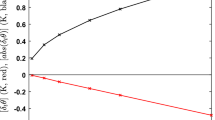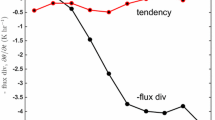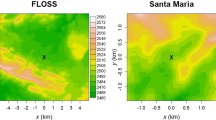Abstract
The vertical mesoscale flux in the nocturnal boundary layer is generally considered to be difficult to estimate because of the small mesoscale vertical velocities and the large random variation of the mesoscale fluxes. However, the mesoscale vertical flux of heat, computed from FLOSSII data, varies quasi-systematically with height, stability and time scale. Such systematic variation requires correction for sonic misalignment and averaging over a large quantity of data. The relation of the mesoscale heat flux to the vertical structure of the nocturnal boundary layer is examined. For the most common conditions, the vertical convergence of the mesoscale heat flux acts to reduce the nocturnal cooling rate. Important uncertainties are discussed as well as the need for improved observations.
Similar content being viewed by others
References
Acevedo O, Osvaldo L, Moraes L, Fitzjarrald D, Sakai R, Mahrt L (2007) Turbulent carbon exchange in very stable conditions. Boundary-Layer Meteorol 125: 49–61
Cava D, Giostra U, Tagliazucca M (2001) Spectral maxima in a perturbed stable boundary layer. Boundary-Layer Meteorol 100: 421–437
Conangla L, Cuxart J, Soler MR (2008) Characterisation of the Nocturnal Boundary Layer at a Site in Northern Spain. Boundary-Layer Meteorol 128: 255–276
Dellwik E, Mann J, Bingöl F, Larsen K (2009) Mean vertical velocities and low tilt angles at a fetch-limited forest site in the context of carbon dioxide vertical advection. Biogeosci Discuss 6: 8167–8213
Finnigan JJ, Clement R, Malhi Y, Leuning R, Cleugh HA (2003) A re-evaluation of long-term flux measurement techniques—Part I: averaging and coordinate rotation. Boundary-Layer Meteorol 107: 1–48
Fritts D, Wang L, Werne J, Lund T, Wan K (2009) Gravity wave instability dynamics at high Reynolds numbers. Part I: Wave field evolution at large amplitudes and high frequencies. J Atmos Sci 66: 1126–1148
Galperin B, Sukoriansky S, Anderson P (2007) On the critical Richardson number in stably stratified turbulence. Atmos Sci Lett 8: 65–69
Grachev AA, Fairall CW, Persson POG, Andreas EL, Guest PS (2005) Stable boundary-layer scaling regimes: the Sheba data. Boundary-Layer Meteorol 116: 201–235
Heinesch B, Yernaux M, Aubinet M (2007) Some methodological questions concerning advection measurements: a case study. Boundary-Layer Meteorol 122: 457–478
Howell J, Mahrt L (1997) Multiresolution flux decomposition. Boundary-Layer Meteorol 83: 117–137
Lee X (1998) On micrometeorological observations of surface-air exchange over tall vegetation. Agric For Meteorol 91: 39–49
Lenschow D, Sun J (2007) The spectral composition of fluxes and variances over land and sea out to the mesoscale. Boundary-Layer Meteorol 125: 63–84
Luhar A, Hurley P, Rayner K (2009) Modelling near-surface low winds over land under stable conditions: sensitivity tests, flux–gradient relationships, and stability parameters. Boundary-Layer Meteorol 130: 249–274
Mahrt L (2007) The influence of transient flow distortion on turbulence in stable weak-wind conditions. Boundary-Layer Meteorol 127: 1–16
Mahrt L, Vickers D (2006) Extremely weak mixing in stable conditions. Boundary-Layer Meteorol 119: 19–39
Mahrt L, Sun J, Blumen W, Delany A, McClean G, Oncley S (1998) Nocturnal boundary-layer regimes. Boundary-Layer Meteorol 88: 255–278
Mahrt L, Lee X, Black A, Neumann H, Staebler RM (2000) Nocturnal mixing in a forest subcanopy. Boundary-Layer Meteorol 101: 67–78
Mallat SG (1989) The theory of multiresolution signal decomposition: the wavlet representation. IEEE Trans Pattern Anal Mach Intell 7: 674–693
Mirocha J, Kosović B, Curry A (2005) Vertical heat transfer in the lower atmosphere over the Arctic Ocean during clear-sky periods. Boundary-Layer Meteorol 117: 37–71
Nakamura R, Mahrt L (2005) A study of intermittent turbulence with CASES-99 tower measurements. Boundary-Layer Meteorol 114: 367–387
Paw U KT, Baldocchi DD, Meyers TP, Wilson KB (2000) Correction of eddy-covariance measurements incorporating both advective effects and density fluxes. Boundary-Layer Meteorol 97: 487–511
Sakai R, Fitzjarrald D, Moore KE (2001) Importance of low-frequency contributions to eddy fluxes observed over rough surfaces. J Appl Meteorol 40: 2178–2192
Stillinger D, Hellend K, Van Atta C (1983) Experiments on the transition of homogeneous turbulence to internal waves in a stratified fluid. J Fluid Mech 131: 91–122
Su H-B, Schmid HP, Grimmond CSB, Vogel CS, Curtis PS (2008) An assessment of observed vertical flux divergence in long-term eddy-covariance measurements over two Midwestern forest ecosystems. Agric For Meteorol 148: 186–205
Sun J (2007) Tilt corrections over complex terrain and their implication for CO2 transport. Boundary-Layer Meteorol 124: 143–159
Sun J, Howell J, Esbensen SK, Mahrt L, Greb CM, Grossman R, LeMone MA (1996) Scale dependence of air-sea fluxes over the Western Equatorial Pacific. J Atmos Sci 53: 2997–3012
Tanner C, Thurtell G (1969) Anmoclinometer measurements of Reynold stress and heat transport in the atmospheric surface layer. Department of Soil Science, University of Wisconsin, Madison, WI, Research and Development Technical Report, ECOM 66-G220F, 82 pp
van den Kroonenberg A, Bange J (2007) Turbulent flux calculation in the polar stable boundary layer: multiresolution flux decomposition and wavelet analysis. J Geophys Res 112: D06112. doi:10.1029/2006JD007819
Vickers D, Mahrt L (2006a) A solution for flux contamination by mesoscale motions with very weak turbulence. Boundary-Layer Meteorol 118: 431–447
Vickers D, Mahrt L (2006b) Contrasting mean vertical motion from tilt correction methods and mass continuity. Agric For Meteorol 138: 93–103
Wilczak JM, Oncley SP, Sage SA (2001) Sonic anemometer tilt correction algorithms. Boundary-Layer Meteorol 99: 127–150
Yagüe C, Viana S, Maqueda G, Redondo JM (2006) Influence of stability on the flux-profile relationships for wind speed, \({\phi_m}\), and temperature, \({\phi_h}\), for the stable atmospheric boundary layer. Nonlinear Process Geophys 13: 185–203
Author information
Authors and Affiliations
Corresponding author
Rights and permissions
About this article
Cite this article
Acevedo, O.C., Mahrt, L. Systematic Vertical Variation of Mesoscale Fluxes in the Nocturnal Boundary Layer. Boundary-Layer Meteorol 135, 19–30 (2010). https://doi.org/10.1007/s10546-010-9465-4
Received:
Accepted:
Published:
Issue Date:
DOI: https://doi.org/10.1007/s10546-010-9465-4




